Parallel Structure: Parallel structures are also called parallelism, is the repetition of a chosen grammatical pattern within a sentence. If each compared item or idea follows the same grammatical pattern, it is said to be a construction of a parallel structure. The elements of the sentence will be in the same grammatical Structure. Not only the phrases and the words but also the verbs have to stay similar.
Parallel structure exercise help paragraphs and letters to flow more for readers. In a parallel structure, the phrases or the words of a sentence start and end similarly, maintaining the rhythm of the lines. Some parallel structure examples in literature are the first paragraph of Charles Dickens’ ‘A Tale of Two Cities”.
In this blog, we will make an effort to discuss about the details of parallel Structure in English. Usually, two parallel sentences are adjoined by conjunctions such as or, and. Therefore, learning about parallel structures not only will improve ones’ English skills but will also help one in their writing works.
Parallel Structure in English
- What is Parallel Structure?
- Difference between Mixed Construction and Parallel Structure
- Important rules of parallel Structure
- The role of parallel Structure in writings
- The takeaway from this article
What is Parallel Structure?
Parallel Structure means having the same pattern of words to emphasize that both the sentences or phrases or words are of the same importance. Not only in Structure, but they should also be the same intensity. Parallel Structure is used to make writing easier to understand, add clarity to their works, and make their writing grammatically and structurally correct.
Difference between Mixed Construction and Parallel Structure
A mixed construction is a sentence with elements that transform from one type of Structure to another type; in this type of sentence, the writer shifts from writing about one idea or element to another, abruptly leading to confusion. For example, a logical sentence has a subject and a predicate. When the subject is introduced in a sentence, there is an expectation about the grammatical direction, and when that expectation doesn’t meet, it leads to a mixed construction.
Example: Teaching a noble profession involves a lot of patience. A mixed construction is just a fancy way of saying that the sentence does not make any sense. At the basic level in a mixed construction, the sentence’s subject does not match with the predicate.
The only major difference between mixed construction and parallel Structure is that in the latter, the elements of the sentence has to remain the same, including the verb tense. On the other hand, in a mixed construction, the sentence begins with a certain structure and ends with another one. As a result, the subject and the sentence’s predicate do not match, which is the polar opposite of a parallel sentence.

Important Rules of Parallel Structure
There are as many as five important rules of parallel Structure. They are :
Parallel Structure with Coordinating Conjunctions
Parallel Structure is used when two clauses are connected with a coordinating conjunction such as for, and, nor, but, so, in a sentence.
Example: Neither will he be singing a song, nor will he dance.
Parallel Structure with Correlative Conjunctions
Parallel Structure is also used when two clauses are connected with correlative conjunction such as either-or, neither nor in a sentence.
Example: Either he likes her, or he doesn’t want to see her.
Parallel Structure with Infinitives
Parallel Structure is also used along with infinitives.
Example: He likes to dance, and he likes to sing songs.
Parallel Structure with -ing Endings
you can also use parallel Structure with words ending with ing. The writer has to keep the verb of the sentence consistent.
Example: Tobi likes running, dancing and being active.
Parallel Structure with Clauses
Parallel Structure is used when writing clauses.
Example: My brother said to get a good education and do not settle for less.
Parallel Structure in Lists with Colons
When there are many items in a list form following a colon, all the items on that list should be in the same order to avoid any parallel structure error.
Example: In his bedroom, you will find the following: a bed, a closet and a desk.
Parallel Structure in other Lists
If the items are not introduced in a list form, still they have to be in a similar pattern for the construction of a parallel structure.
Example: Harry wanted to make sure that he made his presentation effectively, creatively and persuasively.
Parallel Structure in Verb Tense
When it comes to verb tenses, you should use the parallel Structure. In a parallel structure construction, one should be very careful that the verb tense always matches.
Example: Yesterday they watched a movie, played video games and made pasta.
The Importance of parallel structure is that the parallel structure provides a flow to one’s writing. It helps them to show ideas of equal importance. It also helps in keeping balance in one’s writings and makes it easier for the readers. Any error in the construction of a parallel structure will make the writings sound strange.
It is usually very difficult for anyone to point out the mistakes in constructing a parallel structure in order to test one’s writing abilities as well as to rectify their parallel structural errors in many tests. One of those many tests is SAT. Lack of use of parallel Structure can lead to disrupt the rhythm of the writing and leave the sentence grammatically incorrect.
The role of Parallel Structure in writing
A proper parallel structure helps in establishing the balance and maintaining the flow in a constructed sentence. In addition, the clarity brought in by parallel structures helps in the alignment of relatable ideas and readability.
How to Use Parallel Structure
When poets use similar words or phrases across sentences or several lines of poetry, it is said to be parallel sentence structure. This brings a rhythm to their writings. Simple parallel sentence structures are as simple and short as words and phrases. Complex parallel sentence structures may combine entire clauses or sentences. Parallelism is used to highlight the different aspects of a story or a poem in different ways.

Simple Parallel Sentence Structure
In these words, prepositional phrases and infinitive phrases are combined. Simple structure sentences can be divided by using come, semicolon or also with the use of conjunctions, like and, or, but. The lines “From laden boughs, from hands, / sweet fellowship in the bins/ comes nectar at the roadside” from the poem ‘From Blossom’ by Li-Young Lee is a classic example of prepositional phrases in parallel Structure. This brings a flow and rhythm to the poem.
Complex Parallel Sentence Structure
This is used to join lengthier clauses or groups of words to join. Complex parallel sentence structure helps writers compare, emphasize or contrast different aspects of their poems or stories. For example, in the poem ‘Annabel Lee’ by Edgar Allen Poe “, I was a child, and she was a child, then In this kingdom by the sea, But we loved with a love that was more than love- / With a love that the winged seraphs of Heaven / Coveted her and me”.
Here, the poet uses parallel sentence structure with the lines “I was a child” and “she was a child” to emphasize that the lovers were young. In addition, repeating the phrase “with a love” emphasizes the depth of the love mentioned in the lines of the poem.
Faulty Parallelism
This refers to the construction of a sentence structure that is not quite parallel. Rather than grammar, the problem here lies more with the styling of the sentence. For example, a sentence such as “He likes to eat, cook food and play video games” is grammatically correct, but it’s not a parallel sentence structurally. In order to make it a parallel structure, the sentence would look like “He likes eating, cooking food and playing video games”.
The other literary devices used with Parallel Structures
Parallelism in literature always comes up with other literary devices such as rhythm, repetition, alliteration, etc.
Rhythm: The repeated elements are always of the same rhythm or meter. The same stressed syllables are in a pattern in the parallel elements of the sentence or piece. Parallel structures are used by poets to maintain the balance and rhythm of their poem.
Repetition: The root of parallelism is repetition. The phrase structure or the impact of an idea is made stronger by repetition.
Antithesis: Parallelism is often used to contrast two different ideas within the same Structure.
Alliteration: Having the same sound for the list of objects or similar phrases further enhances the parallelism of their writing.
The takeaway from this article
This will be helpful for many students to improve their writing skills. The proper use of parallel structure provides clarity, rhythm, and balance in the writings, be it a poem, essay, or story. In addition, students will find it useful for understanding the meaning of poems and the plots of stories as well as help them in identifying other literary devices such as the alliteration, rhythm, antithesis and others.